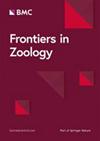Movement and storage of nematocysts across development in the nudibranch Berghia stephanieae (Valdés, 2005)
IF 2.6
2区 生物学
Q1 ZOOLOGY
引用次数: 2
Abstract
Intracellular sequestration requires specialized cellular and molecular mechanisms allowing a predator to retain and use specific organelles that once belonged to its prey. Little is known about how common cellular mechanisms, like phagocytosis, can be modified to selectively internalize and store foreign structures. One form of defensive sequestration involves animals that sequester stinging organelles (nematocysts) from their cnidarian prey. While it has been hypothesized that nematocysts are identified by specialized phagocytic cells for internalization and storage, little is known about the cellular and developmental mechanisms of this process in any metazoan lineage. This knowledge gap is mainly due to a lack of genetically tractable model systems among predators and their cnidarian prey. Here, we introduce the nudibranch Berghia stephanieae as a model system to investigate the cell, developmental, and physiological features of nematocyst sequestration selectivity. We first show that B. stephanieae, which feeds on Exaiptasia diaphana, selectively sequesters nematocysts over other E. diaphana tissues found in their digestive gland. Using confocal microscopy, we document that nematocyst sequestration begins shortly after feeding and prior to the formation of the appendages (cerata) where the organ responsible for sequestration (the cnidosac) resides in adults. This finding is inconsistent with previous studies that place the formation of the cnidosac after cerata emerge. Our results also show, via live imaging assays, that both nematocysts and dinoflagellates can enter the nascent cnidosac structure. This result indicates that selectivity for nematocysts occurs inside the cnidosac in B. stephanieae, likely in the cnidophage cells themselves. Our work highlights the utility of B. stephanieae for future research, because: (1) this species can be cultured in the laboratory, which provides access to all developmental stages, and (2) the transparency of early juveniles makes imaging techniques (and therefore cell and molecular assays) feasible. Our results pave the way for future studies using live imaging and targeted gene editing to identify the molecular mechanisms involved in nematocyst sequestration. Further studies of nematocyst sequestration in B. stephanieae will also allow us to investigate how common cellular mechanisms like phagocytosis can be modified to selectively internalize and store foreign structures.裸鳃棘球绦虫(Berghia stephanieae)线虫囊在发育过程中的运动和储存(vald, 2005)
细胞内隔离需要特殊的细胞和分子机制,使捕食者能够保留和使用曾经属于猎物的特定细胞器。很少有人知道常见的细胞机制,如吞噬作用,是如何被修改以选择性地内化和储存外来结构的。防御性隔离的一种形式涉及动物从刺胞动物猎物身上隔离刺胞细胞器(刺丝囊)。虽然人们假设线虫囊是由专门的吞噬细胞鉴定的,用于内化和储存,但在任何后生动物谱系中,对这一过程的细胞和发育机制知之甚少。这种知识差距主要是由于在捕食者及其刺胞动物猎物之间缺乏遗传上可处理的模型系统。在此,我们以裸鳃棘球菊为模型系统,研究线虫囊选择性的细胞、发育和生理特征。我们首先表明,以棘球绦虫为食的棘球绦虫选择性地隔离线虫囊,而不是在其消化腺中发现的其他棘球绦虫组织。使用共聚焦显微镜,我们记录了线虫囊的分离在进食后不久开始,在附属物(角状体)形成之前,其中负责分离的器官(刺囊)位于成虫体内。这一发现与先前的研究不一致,即刺胞体的形成是在角虫出现之后。我们的研究结果还表明,通过实时成像分析,线虫囊和鞭毛藻都可以进入新生的刺胞结构。这一结果表明,刺丝囊的选择性发生在刺丝囊内,很可能发生在刺丝噬细胞本身。我们的工作强调了stephanieae对未来研究的效用,因为:(1)该物种可以在实验室中培养,这提供了进入所有发育阶段的途径,(2)早期幼虫的透明度使得成像技术(因此细胞和分子分析)变得可行。我们的研究结果为未来使用实时成像和靶向基因编辑来确定线虫囊隔离的分子机制的研究铺平了道路。进一步研究刺丝囊在stephanieae中的隔离也将使我们能够研究如何修改常见的细胞机制,如吞噬作用,以选择性地内化和储存外来结构。
本文章由计算机程序翻译,如有差异,请以英文原文为准。
求助全文
约1分钟内获得全文
求助全文
来源期刊

Frontiers in Zoology
ZOOLOGY-
CiteScore
4.90
自引率
0.00%
发文量
29
审稿时长
>12 weeks
期刊介绍:
Frontiers in Zoology is an open access, peer-reviewed online journal publishing high quality research articles and reviews on all aspects of animal life.
As a biological discipline, zoology has one of the longest histories. Today it occasionally appears as though, due to the rapid expansion of life sciences, zoology has been replaced by more or less independent sub-disciplines amongst which exchange is often sparse. However, the recent advance of molecular methodology into "classical" fields of biology, and the development of theories that can explain phenomena on different levels of organisation, has led to a re-integration of zoological disciplines promoting a broader than usual approach to zoological questions. Zoology has re-emerged as an integrative discipline encompassing the most diverse aspects of animal life, from the level of the gene to the level of the ecosystem.
Frontiers in Zoology is the first open access journal focusing on zoology as a whole. It aims to represent and re-unite the various disciplines that look at animal life from different perspectives and at providing the basis for a comprehensive understanding of zoological phenomena on all levels of analysis. Frontiers in Zoology provides a unique opportunity to publish high quality research and reviews on zoological issues that will be internationally accessible to any reader at no cost.
The journal was initiated and is supported by the Deutsche Zoologische Gesellschaft, one of the largest national zoological societies with more than a century-long tradition in promoting high-level zoological research.
 求助内容:
求助内容: 应助结果提醒方式:
应助结果提醒方式:


